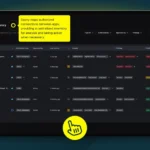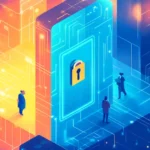SaaS (Software as a Service) is rapidly evolving into a core component of manty organizations due to its ease of implementation, scalability, and low cost of entry, exploding the market size to $273.55 billion. However, managing security within these SaaS environments is complex and challenging, as these platforms hold vast amounts of sensitive data and are accessed from numerous devices and locations.
The stakes are too high for legacy security of just usernames and passwords to keep applications secure. On average, a company exposes 157,000 sensitive records to the internet via SaaS sharing functionalities, equating to a potential data breach risk valued at $28 million. With the growth of cybercrime and attacker’s evolving tactics, organizations must find ways to secure their SaaS without losing out on the benefits that come with having it.
In this article, we investigate the many challenges of managing SaaS environments and offer actionable advice to safeguard them through identity management.
Challenges in SaaS Identity Security
SaaS has become a core component of many businesses, with 85% of IT adoption being SaaS-based, with approximately 400 applications per company. These applications make it easy for businesses to ramp up new technologies without purchasing hardware infrastructure, making it faster to implement and lead to an enormous volume of SaaS applications for organizations to manage.
Much of this SaaS adoption has been business-led, as IT adoption is increasingly driven by business needs rather than IT departments. About 53% of the SaaS expansions are unmanaged or decentralized, lacking direct oversight by IT departments. While this fosters agility and innovation, IT democratization brings challenges to management, which poses risks in security, data governance, and compliance.
The Phenomenon of SaaS Sprawl
The phenomenon of SaaS sprawl is a significant challenge for identity security. SaaS sprawl occurs when an organization adopts many SaaS applications without adequate oversight or coherent management strategies. This scenario leads to many issues in tracking which services are in use, who has access to them, and how they are used.
The problem starts with the credentials, as each application has its own unique set, leading to the complexity of managing and securing user identities across varied platforms. The absence of centralized control hinders the enforcement of consistent security policies and makes these unsupervised SaaS applications prime targets for data breaches.
This sprawl comes with issues in managing user accounts, especially the timely de-provisioning access for former employees or contractors. These accounts can retain access long after the former associate has departed, leaving them access to potentially sensitive information. Failing to track and manage these orphaned accounts can set the organization up for potential security incidents due to unauthorized access. It’s not just the old user who is at risk, but their credentials, which might be stolen and re-used by a malicious entity to masquerade as a one-time legitimate user.
Unpacking Toxic Combinations of Identity Risks
Managing identity risks requires a deep understanding of how different factors can intertwine to escalate risk. A prime example is the combination of excessive privileges and a lack of regular audits.
Often, users in an organization are granted more access rights than necessary for their roles. This situation becomes particularly precarious when compounded by infrequent or inadequate audits. Over-privileged accounts, if not regularly reviewed and adjusted, significantly increase the risk of both internal misuse and external attacks. Attacks that target these accounts with stolen passwords or credential stuffing attacks will ultimately have a more significant impact due to the excessive privilege. This posture makes insider threats more significant as users have more data and access.
The presence of over-privileged accounts in an organization goes beyond escalating the risk of malicious activities and also creates compliance issues. For example, suppose employees have access rights beyond what is necessary. This elevates the potential impact of insider threats, where disgruntled or malicious employees might exploit their access to steal or sabotage sensitive company data. Excessive access allows them to access more than necessary for their role, expanding the reach further. Any threat to the security and integrity of an organization’s data may cause compliance issues with regulations such as GDPR, HIPAA, or CCPA.
Business-led IT: Unveiling the Hidden Dangers of Unmanaged SaaS Applications
Business-led IT has become a driver of innovation and operational agility, allowing organizations to adopt the technology they need when they need it without having to go through the filter of IT. These operational improvements create security considerations for the organization, as unofficial and unmanaged SaaS applications may not align with its established security standards, making them more susceptible to cyber threats. It may not impose strict password management rules or even limit who can use it or what data they can access once they are in, placing sensitive data at risk.
Each unauthorized SaaS application significantly expands an organization’s attack surface by introducing potential vulnerabilities. IT departments cannot routinely monitor or manage them, leaving unnoticed gaps for attackers to exploit. This situation is exacerbated by the interconnected nature of modern IT systems, where a breach in one application can potentially compromise the broader network.
However, the challenges extend beyond security and data management and control. Business-led IT increases the potential for data loss and leakage as it may be stored in locations lacking secure, enterprise-level backup and recovery mechanisms. This absence of infrastructure puts the data at risk of being lost. It also increases the likelihood of data leakage, as these unofficial SaaS applications typically do not possess comprehensive data protection features.
Maintaining SaaS Compliance
Maintaining compliance with SaaS applications is challenging for organizations as they must navigate a complex web of regulations, each with unique requirements. Ensuring their SaaS applications adhere strictly to these diverse and occasionally overlapping standards is complicated.
Central to this compliance challenge are several key areas. It starts with user access control, which involves ensuring that access to sensitive information is granted judiciously and by role-based permissions. Then, it builds on this with identity verification and authorization processes to ensure that only authenticated and authorized users can access specific data or applications. These controls limit who can access the SaaS application and how.
From here, the focus moves to data privacy and security. Most compliance frameworks require stringent measures to protect data from unauthorized access and breaches. This includes implementing encryption, secure data storage, and privacy-focused data handling practices. Consistent monitoring and auditing detect and rectify potential compliance issues to help ensure these controls are effective. These controls are necessary for compliance to be achievable.
SaaS-Specific Considerations
SaaS applications bring unique challenges and considerations that organizations must navigate carefully. A vital aspect of this is understanding the division of security responsibilities between the SaaS vendor and the customer. Notably, vendors are typically responsible for about 90% of the security in a SaaS setup. This leaves identity and access management as one of the few areas where the customer retains significant control, underlining the importance of robust policies.
Data residency and sovereignty present another crucial consideration. SaaS providers often store data in multiple locations, which may not always align with a company’s specific use cases or compliance requirements. Some regulations may prohibit the storage or transfer of data across international borders. Without precise knowledge and oversight of where and how a SaaS provider handles data, an organization can inadvertently find itself at risk of non-compliance.
Integration with existing identity systems is a complex yet vital area. SaaS solutions might integrate with various identity management systems, including single sign-on (SSO) services or third-party authentications. The choice here significantly impacts both management and security. Opting for organizational SSO can streamline management and enhance control over user access. On the other hand, while using third-party authentication services like Google Auth might offer convenience for users, it can also result in diminished control and visibility for the organization.
Finally, user lifecycle management in the context of SaaS solutions requires careful handling. Managing new joiners’ roles and access rights, those moving within the organization, and leavers can be complex. Inadequate management in this area can lead to persistent access rights for former employees, posing a substantial risk. This risk is not limited to potential internal misuse; there’s also the danger of external actors exploiting these credentials.
Automating Identity
Leveraging SaaS solutions does not have to be an accepted risk for organizations. By implementing identity-first SaaS security solutions, organizations can gain visibility over all of the SaaS solutions used by their business and start to exert control over the environment without adding friction, which could impair the benefits of a business-led IT operation.
Containing SaaS Sprawl
An identity-first SaaS security solution is crucial in mitigating the SaaS sprawl. This approach’s core is the capacity to provide comprehensive visibility, which is essential for informed decision-making and maintaining control over the array of SaaS applications used within an organization. By implementing an identity-first solution, companies can effectively monitor users’ access to SaaS apps in real-time, a critical step in managing and securing the digital ecosystem.
This type of solution goes beyond mere monitoring; it cross-references user access data with information from identity providers (IdPs) and cloud workspaces. This cross-referencing is vital in building a clear and accurate picture of how SaaS applications are used and accessed within the organization. Moreover, the solution offers a more nuanced understanding by enriching this data through integration with a SaaS Inventory system. It provides accurate data about workforce usage of SaaS apps and delivers insights into the use of unauthorized apps, which is often a blind spot in traditional IT management.
Such enriched visibility highlights potential security risks associated with SaaS applications. By pinpointing where the risks lie, whether in over-provisioned access rights, unused applications, or unauthorized app usage, organizations can take targeted actions to mitigate these risks. This comprehensive approach is instrumental in tackling the challenges of SaaS sprawl. It ensures that SaaS applications, while driving business efficiency and innovation, do not become liabilities regarding security and compliance.
Breaking Toxic Access
The concept of ‘toxic access’ – combinations of permissions that can pose significant security risks – poses a unique challenge, often eluding detection through manual processes. Identity-first SaaS security solutions are increasingly essential in this context, as they can cross-reference user data and access rights, creating a comprehensive view of the access landscape within the organization. This holistic visibility is particularly advantageous when users hold multiple accounts across various systems, a common scenario in large or technologically diverse organizations.
Such automation not only aids in mapping the access terrain but also empowers IT teams to proactively identify potential problem areas. By detecting these risky combinations early, teams can take preemptive action to resolve them before they escalate into actual security incidents. Another critical aspect in mitigating toxic access is the identification of administrators for unmanaged SaaS applications. This identification is often challenging yet crucial, as these administrators are vital to remediating any issues uncovered, especially in less structured or unmonitored SaaS environments.
Discovering Business-led IT
A fundamental truth with managing business-led IT is that you cannot secure what you do not know exists. This is where identity-first SaaS security solutions are crucial to discovering and managing an organization’s known and unknown SaaS applications. These solutions are adept at continuously identifying all accounts created by the workforce, covering a spectrum of SaaS applications, whether they are under official management or not.
A vital functionality of these solutions is their ability to unearth accounts that have fallen into disuse or have been forgotten by users. This not only aids in cleaning up the digital environment but also in mitigating risks associated with dormant accounts. Moreover, these systems provide detailed visibility into the authentication methods employed across different applications and offer insights into user behavior and security gaps such as missing multi-factor authentication (MFA) or lack of Single Sign On (SSO).
Identifying weak or shared credentials within the system is another pivotal aspect of these solutions. Such credentials pose a significant security risk, often the weakest link in the security chain. They alert security teams about instances where employees might use corporate credentials for personal applications, which can introduce serious security vulnerabilities.
Managing Compliance
Managing SaaS compliance efficiently and effectively is a significant challenge with the proliferation of SaaS applications. Solutions that leverage automation provide the visibility and control necessary to meet various compliance mandates. One of the fundamental features of these solutions is the ability to create a comprehensive audit trail of all user activities and events within SaaS applications, which maintains an accurate and detailed log of interactions, creating a record of continuous compliance.
The power of these solutions extends to simplifying the evidence-gathering process, a traditionally time-consuming and resource-intensive task. Automation facilitates faster and more efficient audits, significantly reducing manual labor and accelerating the audit cycle. Additionally, these solutions maintain a meticulous inventory of SaaS applications used across the organization. This inventory is not just a list; it categorizes the applications, enabling SecOps teams to quickly understand the types of apps used and how they are utilized by different departments.
This categorization is particularly beneficial when identifying specific types of applications, such as developer tools or infrastructure management tools, which are often focal points in audit reviews. Beyond just monitoring and reporting, these solutions offer security automation playbooks. These playbooks can automate certain aspects of the review processes, thereby enhancing efficiency and reducing the likelihood of human error. Furthermore, periodic reports can be generated and sent for management review and sign-off as part of this automated process. This ensures regular oversight and embeds a systematic approach to compliance within the organizational processes.
Savvy Brings Order to Chaos
Savvy emerges as a beacon of clarity in the often chaotic realm of SaaS identity management. With its sophisticated, identity-first approach, Savvy’s identity-first security approach brings order to the sprawl of SaaS applications. It uncovers hidden Business-led IT resources, efficiently breaks down toxic access combinations, and streamlines compliance processes. It’s a comprehensive solution that illuminates the path to better SaaS management and ensures that organizations can navigate this path confidently and efficiently.
Learn how Savvy can transform your organization’s approach to SaaS identity security and schedule a demo to see Savvy in action.
Embracing Savvy is not just about solving current challenges—it’s about future-proofing your SaaS security.


